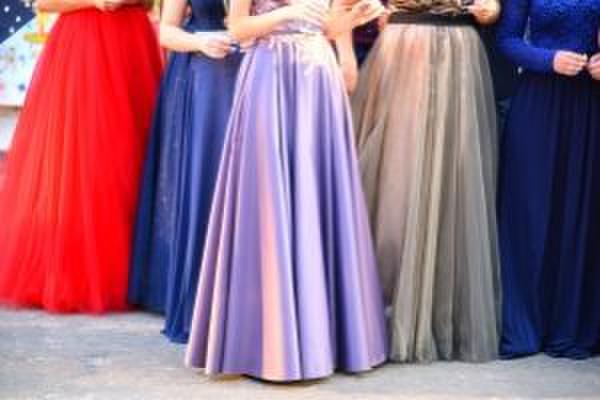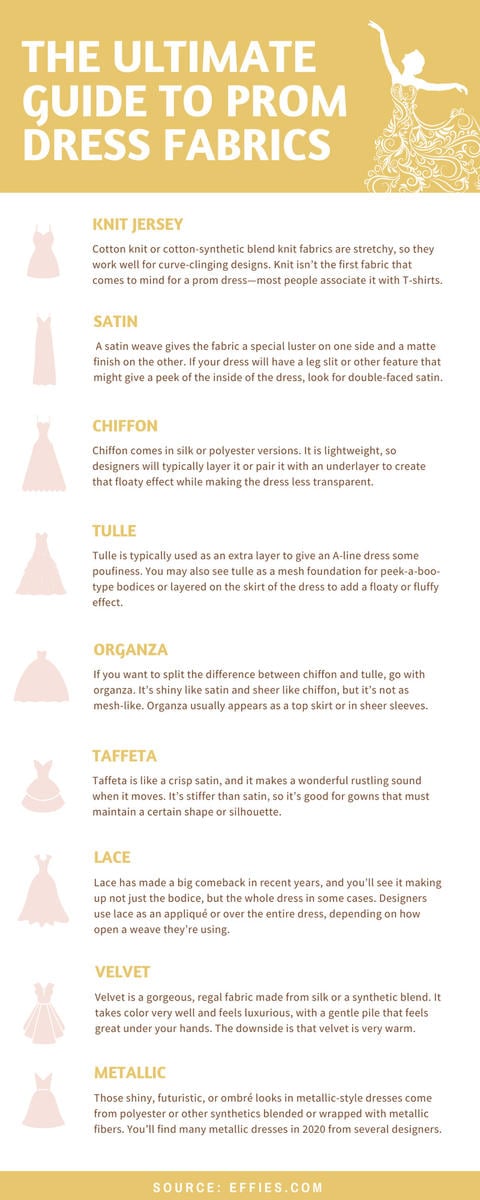The Ultimate Guide to Prom Dress Fabrics

Whether you intend to shimmer in sequins, bedazzle with beads, or enchant with elegance, prom dress fabrics are the foundation of your look. Our ultimate guide to prom dress fabrics will help you compare choices and decide which fabric will create the effect you want. It’s important to understand the differences between prom dress fabrics, especially when you’re buying a prom dress online.
All types of dress materials start as thread, which is fiber that’s twisted or spun into strings ranging from very fine to thick. Prom dresses use fabrics made of both natural and synthetic fibers. Cotton, silk, and wool are the most familiar natural fibers, while rayon and polyester are common synthetics. Fabrics also come in blends of natural and synthetic fibers. The composition of the fabric that makes a prom dress will determine the overall look of the dress, how the dress moves, and whether the dress “breathes” to keep the wearer cool on a hot dance floor.
Things to Consider First
Fit or Flow
Before you dive into the details of different prom dress fabrics, think about the silhouette of the perfect prom dress you picture in your mind. Does it hug the body, or does it flow outward, creating a kind of wafting effect as the wearer walks by? Different fabrics work better for different cuts and styles.
Inside-Out
It’s perfectly natural to concentrate on what the visible parts of the dress look like without thinking about what the inside of the dress will feel like against the body. Undergarments show through some types of dress fabric more than others, so that should also be a consideration when you’re choosing the fabric for your prom dress.
Popular Prom Dress Fabrics
Knit Jersey
This is a bold choice that has become more popular in recent years. Cotton knit or cotton-synthetic blend knit fabrics are stretchy, so they work well for curve-clinging designs. Knit isn’t the first fabric that comes to mind for a prom dress—most people associate it with T-shirts. However, knit has come a long way, and some newer varieties have more texture or sheen. Knit drapes beautifully and works well for form-fitting dresses.
Satin
If shine is your thing, satin is your fabric. A satin weave gives the fabric a special luster on one side and a matte finish on the other. If your dress will have a leg slit or other feature that might give a peek of the inside of the dress, look for double-faced satin.
Chiffon
This is the princess of the prom fabric for the most floaty, feminine look. Chiffon comes in silk or polyester versions. Polyester has evolved to mimic the attributes of silk quite well, and it’s less expensive. Chiffon is lightweight, so designers will typically layer it or pair it with an underlayer to create that floaty effect while making the dress less transparent. If you choose a chiffon dress, watch out for snags—chiffon is delicate and prone to runs. However, if looking like a floaty confection is your dream, go for chiffon.
Tulle
From tutus to crinolines, tulle has been adding that pouf to dresses for years. It’s typically used as an extra layer to give an A-line dress some poufiness. You may also see tulle as a mesh foundation for peek-a-boo-type bodices or layered on the skirt of the dress to add a floaty or fluffy effect.
Organza
If you want to split the difference between chiffon and tulle, go with organza. It’s shiny like satin and sheer like chiffon, but it’s not as mesh-like. Organza usually appears as a top skirt or in sheer sleeves.
Taffeta
Taffeta is like a crisp satin, and it makes a wonderful rustling sound when it moves. It’s stiffer than satin, so it’s good for gowns that must maintain a certain shape or silhouette.
Lace
Lace has made a big comeback in recent years, and you’ll see it making up not just the bodice, but the whole dress in some cases. It’s pretty and feminine. Designers use lace as an appliqué or over the entire dress, depending on how open a weave they’re using.
Sequins
Sequin isn’t really a fabric; a sequined gown will have a mesh, organza, or other type of backing that forms a foundation for the sequins. The same is true of beading, which is added on top of a different fabric. Both sequins and beading will add a glamorous touch to any prom dress.
Velvet
Velvet is a gorgeous, regal fabric made from silk or a synthetic blend. It takes color very well and feels luxurious, with a gentle pile that feels great under your hands. The downside is that velvet is very warm. Still, if you have an early spring prom in a colder climate, velvet might work.
Metallic
Those shiny, futuristic, or ombré looks in metallic-style dresses come from polyester or other synthetics blended or wrapped with metallic fibers. You’ll find many metallic dresses in 2020 from several designers. Several Mac Duggal prom dresses use metallics to gorgeous effect.
Mikado
This is a heavier fabric that doesn’t stretch, so it provides great structure for mermaid- and trumpet-style dresses.
Selecting your dress is the major event, but it isn’t the end of the job of preparing for prom. You’ll need to coordinate undergarments and accessories as well. Depending on your dress, you might want to add earrings, a necklace, or a bracelet—but keep rings and bracelets away from fragile silk or chiffon. You’ll have to choose shoes that flatter the dress and don’t hurt your feet. If your dress is strapless or off-the shoulder, you might choose a wrap or bolero to go with it in case of chilly weather. An evening bag that will carry your keys, phone, ID, tickets, and some cash for emergencies will come in very handy, as will an emergency sewing kit in case of wardrobe malfunction. Remember to shop for your dress early to leave enough time for any necessary alterations.
We at Effie’s hope you’ve found this ultimate guide to prom dress fabrics helpful! If you’d like to try on some of these styles for yourself, schedule a fitting with us.
